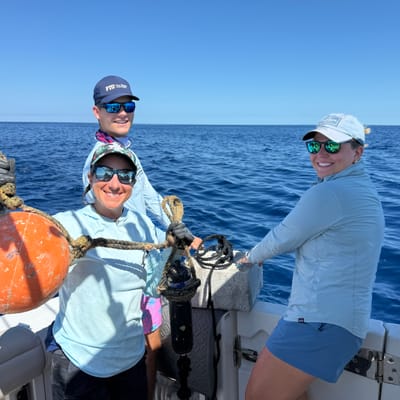Part 2: Permit Spawning Aggregation Dynamics & Predator Ecology in the Florida Keys
SeaKeepers' Vessel DISCOVERY III
Key West, Florida
May 5 - 18, 2025
Project Overview
Permit (Trachinotus falcatus) are a popular sportfish species that form seasonal spawning aggregations on natural and artificial reefs throughout the Florida Keys from March through June. While harvest is prohibited from April 1 to July 31 in the region, catch-and-release angling during this time remains common. However, concerns have emerged regarding the sustainability of this practice due to high rates of depredation—when hooked fish are intercepted by predators before release. In response, the Florida Fish and Wildlife Conservation Commission implemented a seasonal fishing closure at Western Dry Rocks (WDR), a site known for elevated depredation mortality.
To better understand the implications of angling pressure and predator presence during the spawning season, researchers from Florida International University and Carleton University are conducting an ongoing study to evaluate the ecology of permit aggregations and predator foraging behavior. This research supports data-driven management efforts and contributes to a broader understanding of fish population dynamics and predator-prey interactions in the region.
This expedition forms one component of that long-term study, employing a combination of video surveys, hook-and-line sampling, acoustic telemetry, and genetic analysis to investigate spawning behaviors, diet, movement patterns, and predator overlap.
Application
This study aims to assess seasonal and annual variation in permit school size, spatial distribution, and predator presence at key spawning aggregation sites in the Florida Keys. The data collected - including acoustic telemetry, genetic samples, and dietary analysis - will contribute to a growing body of research that informs fisheries management, specifically regarding the sustainability of catch-and-release practices during spawning season and predator impacts on spawning success.
The project also supports the ongoing evaluation of Florida’s seasonal closure at Western Dry Rocks by monitoring the presence and movement of both target and predator species before, during, and after the closure period. Findings will be shared with state and regional stakeholders, including the Florida Fish and Wildlife Conservation Commission and the Bonaire National Marine Park, to guide future conservation decisions.
Expedition Summary
From May 5 - 18, 2025, The International SeaKeepers Society supported researchers from Florida International University and Carleton University in a field expedition focused on permit (Trachinotus falcatus) spawning aggregations and associated predator interactions in the Lower and Middle Florida Keys aboard SeaKeepers’ Vessel DISCOVERY III.
The research aimed to assess permit ecology and relative abundance, evaluate predator foraging behavior, and monitor movement and connectivity between key spawning sites. Researchers used a combination of methods including video surveys, hook-and-line fishing, and acoustic telemetry to gather data on permit (abundance, size distribution, diet, and genetic connectivity) and potential predators (species presence, abundance, and behavior).
Individual fish were tagged with acoustic transmitters to track movement and residency, and underwater receivers were downloaded and redeployed at known aggregation sites. Biological samples were also collected to support dietary and genetic analyses of permit during the spawning season.
Highlights from the expedition include:
- Video surveys indicated that permit abundance at Western Dry Rocks remained comparable to the previous month. Other aggregating species observed included horse-eye jack and gray snapper.
- Permit sizes ranged from 62 to 80 cm fork length, slightly larger than observed in prior surveys.
- Seven permit were acoustically tagged to monitor their movement across spawning sites.
- Seven underwater acoustic receivers were downloaded and redeployed at key locations in the Lower Keys.
- Nineteen cloacal swabs were collected to analyze fecal DNA for dietary assessment, and 23 fin clips were taken to contribute to ongoing research on genetic connectivity across the greater Caribbean.
- One Caribbean reef shark (Carcharhinus perezi) was acoustically tagged to evaluate predator residency and overlap with spawning aggregations at Western Dry Rocks.
- No other potential depredating shark species were observed or tagged during this expedition.
These findings contribute to a broader effort to inform sustainable fisheries management practices and support ongoing permit and predator monitoring across the Florida Keys.
Location
Western Dry Rocks, Florida
Duration of Project
Ongoing since 2018.
Research Team
- Florida International University: Ben Binder, Kirk Gastrich, Gina Clementi, Andrew Natter, Kevin Boswell, Michelle Debbaudt, Devin Heithaus, Chase Schaffhauser
- Carleton University: Jessica Robichaud, Luc LaRochelle
- International SeaKeepers Society: Captains Till Koerber & Aubri Keith


You must be logged in to post a comment.